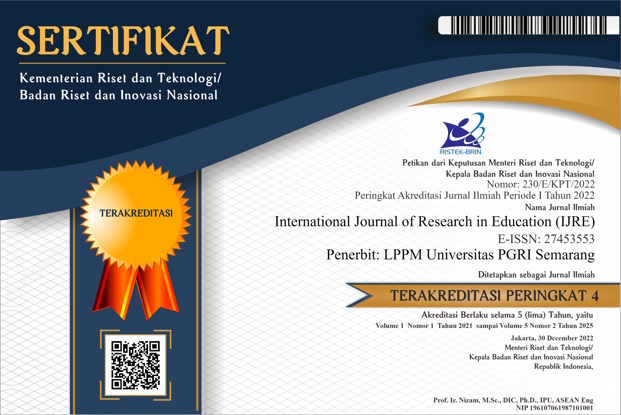E-Module Project Based Learning (PjBL) using Sigil in Basic Vocational Subjects
DOI:
https://doi.org/10.26877/ijre.v5i1.879Keywords:
E-module, Project Based Learning (PjBL), SigilAbstract
There is no learning media that uses the Sigil application, so learning media was created using the Sigil applicationaims to test the level of validity, practicality, and effectiveness of the Project Based Learning (PjBL) E-Module Using Sigil in the Basic Vocational Subject for Grade X Students. The development model in this study uses the development model (ADDIE) with the following steps: (1) Analyze, (2) Design, (3) Development, (4) Implementation and (5) Evaluate. The research subjects were 31 people. The validity test of the E-Module Using Sigil in the Basic Vocational subject obtained a result of 92.73%, with the interpretation of very valid to use. The practicality test of the E-Module using Sigil in the Basic Vocational subject obtained a result of 93.81%, with the interpretation of very practical to use. Meanwhile, the overall effectiveness test results for the E-Module using Sigil in the Basic Vocational subject were 89.29% very effective to use. Thus, it can be concluded that the Project Based Learning (PjBL) E-Module using Sigil in the Basic Vocational subject has been tested for its feasibility, excellence, and can be used in learning activities in the Basic Vocational subject for Class X at SMKN 1 Singkarak.
References
Arsyad, A. (2011). Media Pembelajaran. In PT Raja Gravindo Persada. https://doi.org/10.1016/j.sbspro.2015.03.268
Astalini, Darmaji, Kurniawan, W., Anwar, K., & Kurniawan, D. A. (2019). Effectiveness of using e-module and e-assessment. International Journal of Interactive Mobile Technologies, 13(9), 21–39. https://doi.org/10.3991/ijim.v13i09.11016
Boa Sorte, P., & Kim, N. J. (2023). Integrating augmented reality and problem-based learning into English language teaching through instructional design. In Revista Tempos e Espaços em Educação (Vol. 16, Issue 35). https://doi.org/10.20952/revtee.v16i35.19073
Darmansyah. (2010). Pembelajaran Berbasis WEB Teori Konsep dan Aplikasi. UNP Press.
Hakiki, M., & Sefriani, R. (2022). Peningkatan Kemampuan Berpikir Kritis Mahasiswa Menggunakan Metode Drill/Latihan Dengan Bantuan Media Visual Pada Matakuliah Konsep Teknolgi Informasi. Jurnal Tunas Pendidikan, 4(2), 247–254. https://doi.org/10.52060/pgsd.v4i2.710
Herwina, R., Husnita, L., & Junaidi, J. K. (2023). Pengembangan E-Modul Berbantuan Sigil Software pada Mata Pelajaran Sejarah di Tingkat SMA. Jurnal Pendidikan Tambusai, 7(3), 20292–20300. https://jptam.org/index.php/jptam/article/download/9474/7726
Martin, F., & Ertzberger, J. (2013). Here and now mobile learning: An experimental study on the use of mobile technology. Computers and Education. https://doi.org/10.1016/j.compedu.2013.04.021
Mastery, G. (2024). The Effectiveness of Using Macbox Media to Improve Students ’. 4(2), 219–229.
Priambudi, D., & Sutopo, Y. (2024). Augmented Reality Learning Media with a Problem-Based Learning Model to Enhance the Students ’ Comprehension on Mathematical Concepts. 4(2), 323–334.
Puspasari, D. (2022). Pengembangan Bahan Ajar Interaktif Sigil pada Materi Komunikasi Efektif Kehumasan di SMKN 2 Buduran Sidoarjo. Jurnal Pendidikan Tambusai, 6, 10311–10322. https://jptam.org/index.php/jptam/article/view/4042
Rahmatullah, R., Syahril, S., & Abdullah, R. (2021). The Effectiveness of the Learning Module Cooperative Learning Student Facilitator and Explaining. Journal of Education Technology, 5(1), 123. https://doi.org/10.23887/jet.v5i1.29954
Rasto. (2012). Pendidikan kejuruan. Pendidikan Kejuruan.
Sefriani, Rini. Wijaya, I. (2018). INTERACTIVE MULTIMEDIA LEARNING MODULE BASED ON ADOBE DIRECTOR ON OPERATION SYSTEM COURSE ON VOCATIONAL HIGH SCHOOL. INTECOMS, 1(1). https://doi.org/https://doi.org/10.31539/intecoms.v1i1.124
Sefriani, R., & Sepriana, R. (2020). Development of schoology-based E-learning media on technology and vocational education curriculum learning (in Indonesian). Edukatif : Jurnal Ilmu Pendidikan, 2(1), 9–14. https://doi.org/10.31004/edukatif.v2i1.76
Sefriani, R., Sepriana, R., Radyuli, P., & Hakiki, M. (2022). Android-Based Blended Maintenance Lectures Learning Media for Computer. Journal of Education Technology, 6(1), 119–125. https://ejournal.undiksha.ac.id/index.php/JET/article/viewFile/42514/21290
Sugiyono. (2014). Metode Penelitian Pendidikan (Pendekatan Kuantitatif, Kualitatif dan R&D). Alfabeta.
Supandi, A. (2022). Pengaruh Model Pembelajaran Berbasis Proyek (Project Based Learning) Terhadap Minat Berwirausaha Siswa Kelas Xi Pada Mata Pelajaran Kewirausahaan Di Sekolah Smk Bina Nusa Mandiri Ciracas. Jurnal Review Pendidikan Dan Pengajaran, 5(1), 134–141. https://doi.org/10.31004/jrpp.v5i1.6077
Wijaya, I., Jafnihirda, L., & Fadillah, N. (2020). Perancangan Media Pembelajaran BimbinganTIK Berbasis Android Siswa SMK Jurusan Bisnis Konstruksi dan Propeti. Jurnal Pti (Pendidikan Dan Teknologi Informasi) Fakultas Keguruan Ilmu Pendidikan Universita Putra Indonesia “Yptk” Padang, 7(2), 26–34. https://doi.org/10.35134/jpti.v7i2.31
YANİAWATİ, P., AL-TAMMAR, J., SUPİANTİ, I. I., MD OSMAN, S. Z., & SAEFUL MALİK, A. (2021). Sigil Software: E-Module Development and Effect on Self-Regulated Learning. Journal for the Education of Gifted Young Scientists, 9(3), 251–268.
Yolanda, S., Gistitatuati, N., Sabandi, A., & Irsyad. (2021). Iklim Sekolah di Sekolah Menengah Kejuruan Negeri 3 Padang. Jurnal Bahana Manajemen Pendidikan, 7(1), 41–46. https://doi.org/10.24036/XXXXXXXXXX-X-XX
Zain, S. B. D. D. A. (n.d.). Strategi Belajar Mengajar. Rineka Cipta.



